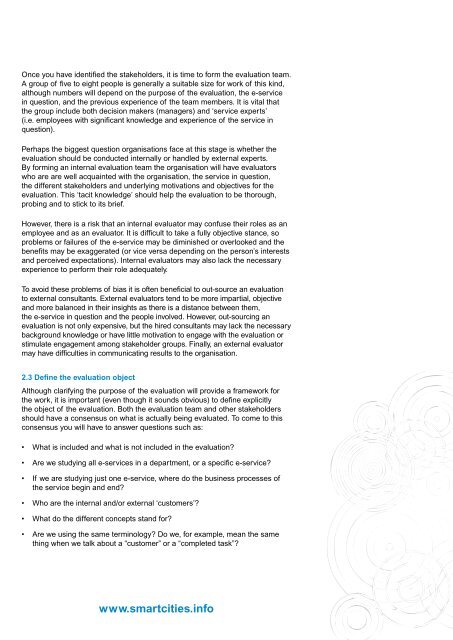Evaluating the impact of local e-services - Smart Cities
Evaluating the impact of local e-services - Smart Cities
Evaluating the impact of local e-services - Smart Cities
You also want an ePaper? Increase the reach of your titles
YUMPU automatically turns print PDFs into web optimized ePapers that Google loves.
Once you have identified <strong>the</strong> stakeholders, it is time to form <strong>the</strong> evaluation team.<br />
A group <strong>of</strong> five to eight people is generally a suitable size for work <strong>of</strong> this kind,<br />
although numbers will depend on <strong>the</strong> purpose <strong>of</strong> <strong>the</strong> evaluation, <strong>the</strong> e-service<br />
in question, and <strong>the</strong> previous experience <strong>of</strong> <strong>the</strong> team members. It is vital that<br />
<strong>the</strong> group include both decision makers (managers) and ‘service experts’<br />
(i.e. employees with significant knowledge and experience <strong>of</strong> <strong>the</strong> service in<br />
question).<br />
Perhaps <strong>the</strong> biggest question organisations face at this stage is whe<strong>the</strong>r <strong>the</strong><br />
evaluation should be conducted internally or handled by external experts.<br />
By forming an internal evaluation team <strong>the</strong> organisation will have evaluators<br />
who are are well acquainted with <strong>the</strong> organisation, <strong>the</strong> service in question,<br />
<strong>the</strong> different stakeholders and underlying motivations and objectives for <strong>the</strong><br />
evaluation. This ‘tacit knowledge’ should help <strong>the</strong> evaluation to be thorough,<br />
probing and to stick to its brief.<br />
However, <strong>the</strong>re is a risk that an internal evaluator may confuse <strong>the</strong>ir roles as an<br />
employee and as an evaluator. It is difficult to take a fully objective stance, so<br />
problems or failures <strong>of</strong> <strong>the</strong> e-service may be diminished or overlooked and <strong>the</strong><br />
benefits may be exaggerated (or vice versa depending on <strong>the</strong> person’s interests<br />
and perceived expectations). Internal evaluators may also lack <strong>the</strong> necessary<br />
experience to perform <strong>the</strong>ir role adequately.<br />
To avoid <strong>the</strong>se problems <strong>of</strong> bias it is <strong>of</strong>ten beneficial to out-source an evaluation<br />
to external consultants. External evaluators tend to be more impartial, objective<br />
and more balanced in <strong>the</strong>ir insights as <strong>the</strong>re is a distance between <strong>the</strong>m,<br />
<strong>the</strong> e-service in question and <strong>the</strong> people involved. However, out-sourcing an<br />
evaluation is not only expensive, but <strong>the</strong> hired consultants may lack <strong>the</strong> necessary<br />
background knowledge or have little motivation to engage with <strong>the</strong> evaluation or<br />
stimulate engagement among stakeholder groups. Finally, an external evaluator<br />
may have difficulties in communicating results to <strong>the</strong> organisation.<br />
2.3 Define <strong>the</strong> evaluation object<br />
Although clarifying <strong>the</strong> purpose <strong>of</strong> <strong>the</strong> evaluation will provide a framework for<br />
<strong>the</strong> work, it is important (even though it sounds obvious) to define explicitly<br />
<strong>the</strong> object <strong>of</strong> <strong>the</strong> evaluation. Both <strong>the</strong> evaluation team and o<strong>the</strong>r stakeholders<br />
should have a consensus on what is actually being evaluated. To come to this<br />
consensus you will have to answer questions such as:<br />
• What is included and what is not included in <strong>the</strong> evaluation?<br />
• Are we studying all e-<strong>services</strong> in a department, or a specific e-service?<br />
• If we are studying just one e-service, where do <strong>the</strong> business processes <strong>of</strong><br />
<strong>the</strong> service begin and end?<br />
• Who are <strong>the</strong> internal and/or external ‘customers’?<br />
• What do <strong>the</strong> different concepts stand for?<br />
• Are we using <strong>the</strong> same terminology? Do we, for example, mean <strong>the</strong> same<br />
thing when we talk about a “customer” or a “completed task”?<br />
www.smartcities.info



